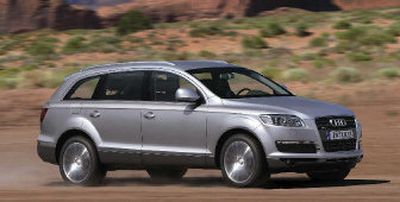Q7: Audi’s first SUV a winner

High fuel prices have hit the full-size sport-utility category like a body blow to the gut.
But the segment won’t go away; many thousands of drivers count on SUVs, especially in climates like ours, and good, new products will always find a home.
Audi has just launched one of the best, its all-new Q7 luxury-performance sport-ute.
Beautifully styled inside and out and featuring outstanding drivetrain and suspension packages, the Q7 is Audi’s first SUV and is expected to become one of its top-selling models.
The Q7 is handsomely turned out; its application of the family’s controversial grille design may be the most successful yet and its lines are clean, bold and strong. In my estimation, it’s among the most attractive of the crossovers.
The interior, which incorporates the obligatory third-row seating package, resembles that of the midsize A6, which is among the best in the business.
Lit by a warm red glow from the dashboard lights, the cabin layout neatly marries tech with timeless design. Sculpted chrome accents brighten the understated and elegant atmosphere, the dash surfaces are pleasing to the eye and the touch and the controls are neatly packaged.
The seats are deeply bolstered and terrifically supportive and even second-row passengers have their own climate controls and optionally heated seats.
Audi’s MMI (Multimedia Interface) is the most intuitive of the electronic driver interfaces of which high-end manufacturers are so enamored.
Its goal to be known as the world’s most innovative car company finds interesting expression in the Q7. Highlights include an optional, $500 Side Assist function that alerts Q7 drivers when another vehicle has entered the driver’s blind spot.
Or consider the Q7 windshield wipers, which are little mini-marvels of engineering finesse.
In the first place, they reverse direction electronically, rather than hydraulically. Moreover, the right arm lifts slightly during the extreme edge of its sweep, extend the driver’s field of vision as far as possible.
At rest, the wipers lie in the hood’s slipstream, where they are out of sight. But the benefit is more than aesthetic — tucked away, they allow the uninterrupted flow of air over the vehicle.
Each time they are turned off, they come to rest in a slightly different position, retarding their deterioration and when at rest at temperatures below 40 degrees, they lift slightly from the windshield, where they are heated by the interior air vents and cannot be frozen to the windshield.
That kind of attention to detail speaks volumes about a manufacturer’s commitment to quality and it’s carried out throughout the Q7.
The Q7 is built on the same platform as the Volkswagen Touareg and Porsche Cayenne, but shares less than 15 percent of its content with its cousins and presents a driving experience distinct from either.
At 5,269 pounds, it’s no lightweight — the doors close with that solid thud that says heft — but when asked to dance the Q7 is nimble and light on its feet. One moment, it’s lumbering up a rock-strewn cart path, the next it’s blasting through fast transitions on a fast downhill run with a near-absence of body lean.
That observation must be tempered by the fact that the rig we tested was equipped with the optional air suspension system ($2,600), which is abetted by an electronically controlled damping system. Its ability to control the Q7’s bulk seems to defy the laws of physics.
The suspension offers three settings ranging from very sporty to comfortable; it must be said that the sporty mode is not uncomfortable and most drivers will find the comfort mode plenty sporty.
Ride height can be altered from the default of 7.1 inches, to more than 11 inches for off-road travel and less than 6 inches for ease of loading heavy objects.
The base, double-wishbone suspension is generously studded with aluminum components, which doubtless contributes to the Q7’s light-footedness. The quattro all-wheel-drive’s 48 front/52 rear default torque split plays a role, too.
The hydraulic steering system earns props for its accuracy, responsiveness and direct feel.
Until fall, when a six-cylinder version will be introduced, the only engine choice is a 350-hp, 4.2-liter V-8, which burbles along happily at highway speeds but morphs into something more purposeful when prodded by the driver’s right foot.
Torque is channeled through a six-speed Tiptronic automatic with Sport mode; it’s a lovely transmission but one couldn’t help but wonder if Audi didn’t consider using the marvelous DSG clutchless manual.
Those obsessed with acceleration will want another 50 horsepower as the Q7 clocks zero-to-60 in the mid-8-second range, while those chasing fuel economy will be disheartened by its 14 city/19 highway EPA ratings.
They say good things come to those who wait, and God knows the Audi faithful have been waiting years for the first sport-ute from their favorite maker. Fuel prices will deter some and cause others to wait until the six is available, but in any case the Q7 is destined to be a key player in the Audi stable.
It’s a superb player in a competitive category.